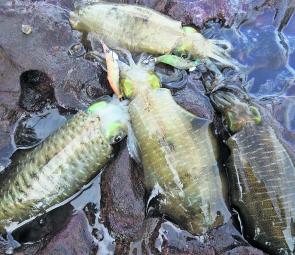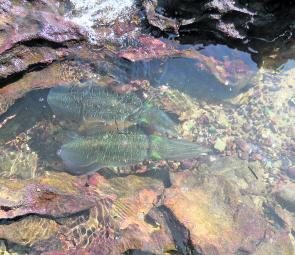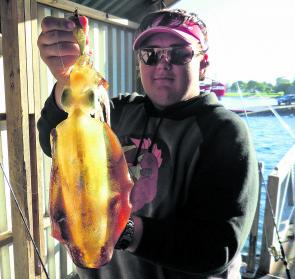Squid are often perceived as a species most commonly caught at night but what most anglers don’t know is that they are easily caught during the day as well.
Winter brings consistently good weather to South East Queensland, so water clarity improves greatly throughout Moreton Bay and surrounding areas, which makes it an ideal time to chase some tiger squid. In fact, with spring just around the corner, August sees an exceptional number of larger squid in the mix throughout this area.
Tiger squid are one of the largest and most common species of squid to be found in Moreton Bay. They are easily accessible for most land-based anglers, as they love to hang in clear, relatively shallow water in and around rock, weed and rubble. They are very fast growing and in most circumstances can live for around a year, growing from a very small egg to 1kg and around 30cm in the tube. However, they can most certainly grow a lot bigger and live a little longer in some circumstances. With such an exceptional growth rate, tiger squid are constantly on the hunt and looking for food to survive, making them a viable target. They are also quite aggressive and can be a very visual species in clear shallow water.
Most anglers think tiger squid are a little trickly to catch but they really aren’t. It’s easier than you think, as I will explain.
Before you can catch tiger squid, you’ll need a good set up.
When targeting squid, your rod’s action is very important. You can go out and buy a purpose built squid outfit but, honestly, you can use most 2-5kg rods fitted with a 2000 or 2500 sized reel.
A relatively soft 2-5kg rod is what you are really after. It will do most of the work absorbing the tiger squid’s lunges while fighting without applying too much pressure to the squid, so as to not tear the squid jig prongs through the squid’s soft tentacles. A relatively soft rod will also allow you to work squid jigs really well. As you start jerking and twitching the rod, it will really get that jig darting, hopefully getting the squid really fired up and interested in eating the jig.
When it comes to reels, a 2000 or 2500 size reel is perfect but you want to run a relatively light drag setting. You want it to be just tight enough to set the prongs when you strike, so a drag setting of below 1kg is perfect. You will find the right drag setting with experience.
When it comes to your main line, you can use either mono or braid but for land-based squidding I prefer braid just because of the added cast ability, since you want to cover as much area as you can. A pound rating of something between 8-12lb is perfect as mainline. It may seem to be a lot for tiger squid but the higher weight ratings are better for knot strength, they allow you to land squid easier, you won’t cast jigs off and it makes pulling jigs off snags much easier.
As for leaders, something around 10-12lb, either fluorocarbon or mono will do the job. You just want something with a bit of an abrasion resistance, as your jig will make contact with the bottom a fair bit.
Squid jigs, also known as egis, come in various shapes, sizes and colours but certain ones work better than others depending on the situations and conditions.
For squidding you can’t have one jig for all conditions, you need a little variety to help get the results. These days there are so many different squid jig brands, sizes, colours, patterns and actions. I find if you spend the money on quality jigs you’ll have more success; it’ll have better action, huge variety of quality colours and patterns, and are more durable and designed to be relatively snagless compared to cheaper jigs.
I tend to use a lot of Daiwa and Yamashita jigs, this is due to the availability, value for money and variety. The jigs I prefer from Yamashita are the Egi OH Q Lives and Sutte R’s; from Daiwa, I use the Emeraldas Nudes. Daiwa and Yamashita jigs are stocked at most good tackle stores and retail for around $14-20 each. Pricy I know, but they are worth their weight in gold.
Certain jig colours work better in certain situations. Over the years, I have found a select few sizes and colours of squid jigs work in most conditions to catch tiger squid during the day. For day squidding, I generally have 8 go-to jigs. I have 4 in size 2.5 and 4 in 3.0. For both sizes, I use 4 bright fluorescent coloured jigs; for example, one bright pink and silver in 2.5 and 3.0, and 1 bright green and gold in 2.5 and 3.0. The last 4 jigs are 1 fish pattern jig and 1 prawn pattern jig in both 2.5 and 3.0.
The bright fluorescent colours with gold or silver flash are very versatile and able to be used in most conditions but are very successful in overcast conditions as the bright colour stands out with a little flash to attract the squid. The fish and prawn patterns are best suited to nice sunny conditions as the flash attracts the squid, plus squid can’t resist attacking them as they are so life-like and look the same as prey that they predominately feed on.
These aren’t the only colours that you can use. There are many other colours available, so use what you are comfortable with. If you want to get really specific on squid colours there are squid jig charts online that tell you exactly what jig to use in specific situations and conditions.
As for jig size, I mentioned 2.5 and 3.0 because I find them to be the most effective size. As you start to blind cast over likely looking tiger squid areas, you’ll want to let out as much colour and flash into the water as you can and these bigger profile jigs are very visible to the squid from a distance. Tiger squid will easily tackle larger sized jigs because they are very opportunistic and aggressive feeders. By far the best all-round jig size is a 2.5 as it can be used throughout the whole squid season with great success and it is a great size for large, medium and small tiger squid.
The other factors that affect which jig size to use are the conditions in the location that you’re squidding. If there is a lot of current or wind, or both, and if the water is relatively deep you’ll need a larger jig like a 3.0 to get a better connection with the bottom as the tiger squid will generally hang very close to the sea floor during the day.
Once you are all set up and ready to target some tiger squid, it’s time to find them.
Tiger squid are very structure-orientated during the day and hold close to the bottom, camouflaging into their surroundings and holding in vast areas that consist of a lot of weed, seagrass, rocks, reef and rubble. These areas also hold a lot of prey that the squid hunt such as fish, prawns, crabs and other crustaceans.
There are many land-based locations around South East Queensland to target tiger squid, such as Bribie Island, Scarborough, Redcliffe, Shorncliffe, Wynnum, Manly, Wellington Point, Cleveland and Raby Bay, Victoria Point, Redlands, Dunwich, Amity Point and all throughout the Gold Coast. All these spots hold good numbers of squid from now through to the next few months.
Some of the best land-based areas to focus your efforts are places like rock walls and jetties. You will generally find the ideal structure for squid around them and you are also elevated and able to over look the area. From here, you are able to look for vast areas of ideal seafloor terrain that you are able to blind cast your jig over in the search for tiger squid. It also makes seeing the squid much easier if they follow your jig back or if they are sitting below you.
A great way to find these ideal locations that consists of vast areas of rocks, weed and reef is to use Google Earth. It will show you the structure on the bottom of relatively shallow and some deep areas, and help you find heavily structured spots and areas around accessible land-based locations.
When it comes to tides, tiger squid will actively move with the tides. While the tide is rising, the tiger squid will move up into shallow water and as the tide recedes, they’ll move back to deeper areas, all in the pursuit of prey. Tiger squid are also very lazy and don’t like huge current flow, but if they’re in areas with a lot of current, fish the very top and bottom of the tides as that’s when the tiger squid will be the most active.
As for depth, squid can be found in any depth but look for shallow water where you are able to see the bottom relatively clearly to 5-10m deep. The most important thing to look for and have while squidding is clean, relatively clear water. Since squid are sight hunters, they need clear water to sight their pretty from a distance and hunt it down.
Weather affects squidding. You want lower wind speeds so you are able to work your jigs with ease but either sunny or over cast conditions will work. In overcast conditions, the squid will be a bit more active and move around a bit more, but when it is quite sunny, they like to sit on structure and only move around a little and wait for food to come past them.
The way you work your squid jigs is very similar to how you would work a soft plastic, but it’s a little more aggressive.
You really want to elevate the squid jig up through the water column and let it slowly sink back down, it’s during that slow sink where the tiger squid will attack the jig and the longer you can make the fall time, or keep in the squids field of vision, the better.
What I generally do when I come to a spot with a very expansive area is make a very long blind cast out as far as I can over it and work my jig back over it. I first let the jig sink all the way down to the bottom, once the jig hits the bottom, I will impart 2-5 sharp or slow whips of the rod depending on the depth, and then I’ll let the jig sink back down. Once the jig has hit the bottom, I will repeat the process until I bring the jig back to myself. From then on I will pepper as many casts as I can over the area till a squid attacks the jig on the drop. If I don’t catch or find any squid I will generally move on to another spot and work the area over again later as the squid will move around.
If I do manage to catch a squid, I will either feel it take the jig, that’s when I will strike it, or I will start my jigging again and will strike it with the jigging technique.
When you hook a squid they feel almost like a dead weight, then it will start shooting off and lunging trying to get away, that’s when you let the squid run and take a little drag until it gets tired. Pull it in slowly, but be careful when landing one as they will try to ink you. If they are badly hooked, you may need to take a little care when landing it. Try beaching it or pull it up on to a rock or step, you could also even use a net.
Once you have caught the squid, take the jig out and cast to where you hooked it as more often than not, one or a few of its mates followed him in. Squid generally school up, so in a trip you can expect multiple hook ups. Sometimes the squid will follow the jig back to your feet, that’s where you can hop the jig a little and pause it, then you should be able to watch the squid attack it. Once the squid has the jig wrapped in its tentacles give it a good strike to set the barbs.
If you go squidding in deeper water, use the same technique, but try and feel your jig as it’s sinking to the bottom and try to work the jig as close to the bottom as possible if it a steep rock wall. It’s also important to work the jig back up the wall; often you will find a few squid hanging along it.
Tiger squid make for great feed and great bait. Once you have caught them, put them in a fresh bucket of seawater or plastic bag then transfer them to an esky full of ice as quick as possible. Alternatively, you can use a squid kill bag with a few frozen blocks, this will help to make it taste better for you.
Another humane way of killing the squid is to use a squid spike. Give them a few jabs around the neck between the hood and head. This causes the squid’s muscles to relax, giving you a better product. Likewise, a quick karate chop between the head and body works well, but be warned, sometimes this method can be messy.
Squid are great fun to catch. They are a very visual target species that are excellent eating and also one of the best fresh baits.
While most people target squid at night from the shore, most anglers don’t pressure the humble tiger squid that much during the day. They are just as active as at night, except they just change their behaviour slightly during the day. There isn’t much rest for the tiger squid as they generally live a year and all it really focuses on is its next meal.
Hopefully this will help you catch some tiger squid during the day when not much else is on the chew. If you want to know any more info on how to catch squid in Queensland, jump on to the Brisbane Egi Club Forum at brisbaneegiclub.forumotion.com, the users will be happy to help you with any questions that you have. The club also has squidding comps and squidding socials where you’re paired up with someone who is an experience squid angler and shown how to catch tiger squid, you may even win a few prizes.
Reads: 33338
When tiger squid school up, they can be picked off fairly easily one by one. Having a second angler with you makes this process easier and more fun.

Keen squid angler Bob Thornton with a hefty tiger taken along a rock wall in broad daylight.

Squid are masters at blending into their environment and it’s easy to see how a squid following your jig could be missed or overlooked.

The author with an impressive tiger in excess of 1kg. Tigers of this size are a prized capture and provide plenty of meat for a few people.

Darcy Paton holds up another tiger pushing that magic 1kg mark. Jetties are great places to sight and capture these succulent cephalopods.

A decent brace of jetty caught squid. The colours of these animals are just amazing.

The Yamashita Egi OH Q Live in size 2.5 is a fantastic all-round jig for land-based squidding during daylight hours. Here are some of the author’s favourite colours.




